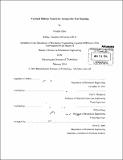| dc.contributor.advisor | Carl V. Thompson and Evelyn Wang. | en_US |
| dc.contributor.author | Zhao, Hangbo | en_US |
| dc.contributor.other | Massachusetts Institute of Technology. Department of Mechanical Engineering. | en_US |
| dc.date.accessioned | 2014-06-13T22:38:08Z | |
| dc.date.available | 2014-06-13T22:38:08Z | |
| dc.date.copyright | 2013 | en_US |
| dc.date.issued | 2014 | en_US |
| dc.identifier.uri | http://hdl.handle.net/1721.1/87971 | |
| dc.description | Thesis: S.M., Massachusetts Institute of Technology, Department of Mechanical Engineering, February 2014. | en_US |
| dc.description | Cataloged from PDF version of thesis. "February 2014." | en_US |
| dc.description | Includes bibliographical references (pages 92-97). | en_US |
| dc.description.abstract | The goal of this research was to fabricate and characterize vertically aligned silicon nanowire gas sensors. Silicon nanowires are very attractive for gas sensing applications and vertically aligned silicon nanowires are preferred over horizontal nanowires for gas sensing due to the high density of nanowire arrays and the increased nanowire surface area per substrate area. However, the development of such devices has been limited by a number of challenges. Two of the key challenges in fabricating vertical silicon nanowire sensors are the difficulty of making electrical contact to the tops of the wires and the large serial resistance of the substrate. In this thesis, highly ordered, dense arrays of vertically aligned silicon nanowires in patterned areas have been fabricated utilizing metal assisted chemical etching (MACE) in combination with interference lithography. In addition, we report a novel and simple approach for making reliable top electrical contacts by using tilted electron beam evaporation with a custom-built rotation plate. A suspended metal top contact layer was formed on vertically aligned silicon nanowires using this approach. We have also systematically investigated the contact behavior between silicon nanowires and metal electrodes with different nanowire doping and contact materials. Ohmic contact was formed between the suspended top metal layer and the tips of silicon nanowires. We have also solved the serial resistance problem by using lightly doped epitaxial silicon films (needed for the sensors) on heavily doped substrates. Based on these techniques and design considerations, we have successfully fabricated vertically aligned silicon nanowire field effect gas sensors. Finally, we have demonstrated highly sensitive detection of hydrogen, oxygen, 10 ppm (parts-per-million, 10-⁶) ammonia and nitrogen dioxide gases using the fabricated sensor devices at room temperature. The sensors have exhibited the highest sensitivity per unit chip area for hydrogen, oxygen and 10 ppm NH₃ gases at room temperature, among other vertically aligned silicon nanowire based gas sensors reported. Further improvements of the current sensor devices can be made to accelerate response and recovery of gas sensing. | en_US |
| dc.description.statementofresponsibility | by Hangbo Zhao. | en_US |
| dc.format.extent | 97 pages | en_US |
| dc.language.iso | eng | en_US |
| dc.publisher | Massachusetts Institute of Technology | en_US |
| dc.rights | M.I.T. theses are protected by copyright. They may be viewed from this source for any purpose, but reproduction or distribution in any format is prohibited without written permission. See provided URL for inquiries about permission. | en_US |
| dc.rights.uri | http://dspace.mit.edu/handle/1721.1/7582 | en_US |
| dc.subject | Mechanical Engineering. | en_US |
| dc.title | Vertical silicon nanowire arrays for gas sensing | en_US |
| dc.type | Thesis | en_US |
| dc.description.degree | S.M. | en_US |
| dc.contributor.department | Massachusetts Institute of Technology. Department of Mechanical Engineering | |
| dc.identifier.oclc | 880689356 | en_US |
